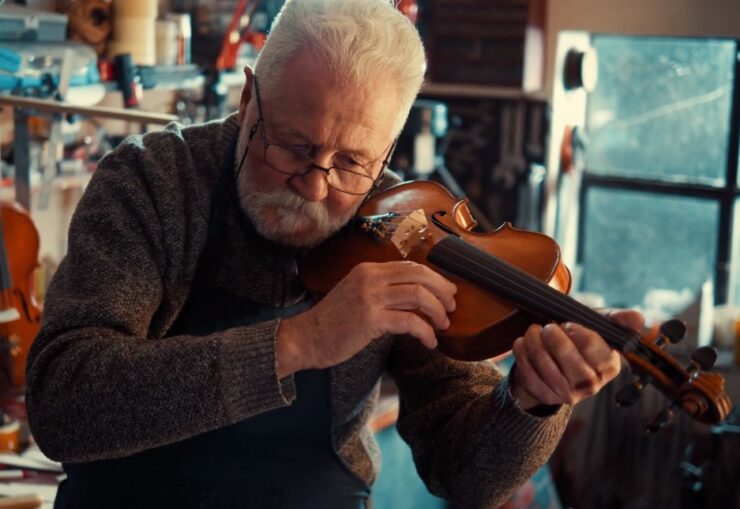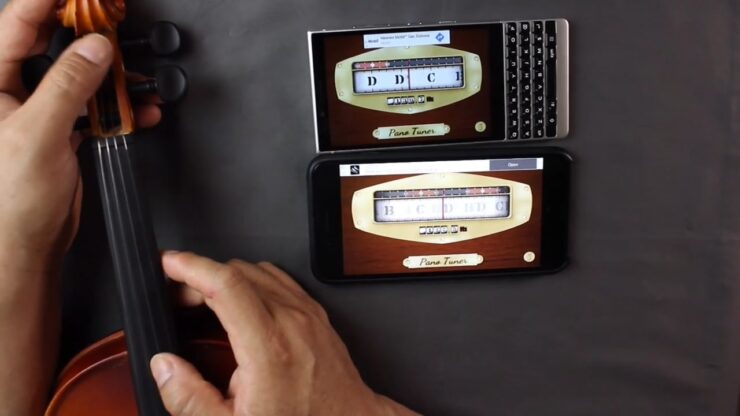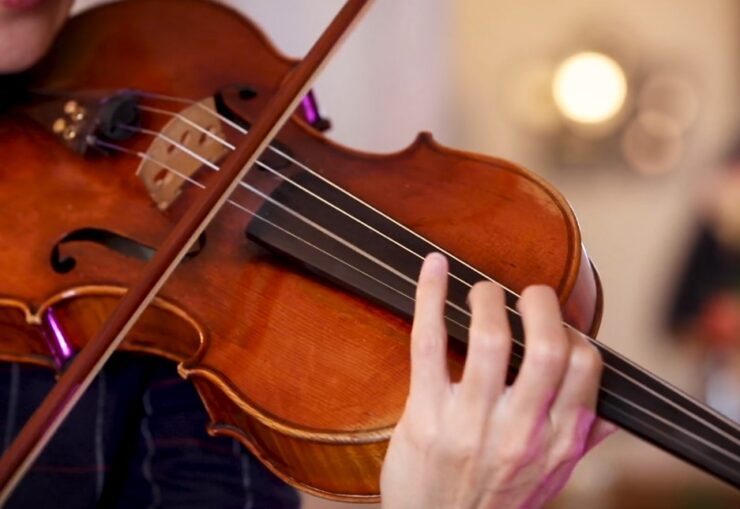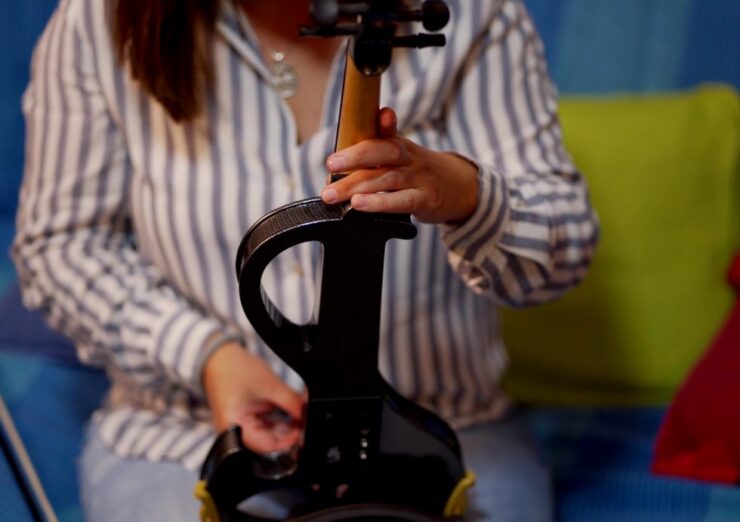Tuning a violin is an essential part of playing the instrument, but not everyone has access to a tuner. Fortunately, it’s still possible to tune a violin without a tuner using other methods.
In this article, we’ll provide you with a step-by-step guide on how to tune a violin without a tuner, including using a piano, a tuning fork, or even just your own ear. Whether you’re a beginner or an experienced violinist, these tips will help you achieve accurate and harmonious tuning for your instrument.
Understanding Pitch and Tune
Tuning a violin without a tuner can be tricky, especially if you’re a newbie. However, with practice, you can learn the basics of violin tuning!
Pitch and tune are essential concepts to understand. Here’s how to do it without a tuner. Let’s explore!
Tune using the A note

It is crucial for tuning a violin without a tuner. It provides a reference pitch for other strings and helps keep them in tune with other instruments. Here’s how to tune your violin using the A note:
- Get an accurate pitch from a tuner or pitch pipe. Press the A string on the fingerboard with your left hand and turn the peg or fine tuner till the pitch matches the one from the tuner or pitch pipe.
- Use the A string as a reference pitch to tune the other strings. For instance, to tune the D string, play the A string while pressing the D string.
- Tune the D string’s tuner or peg until its pitch matches the pitch of the A string.
- Tune the remaining strings (G and E) the same way.
Remember to check and adjust the strings’ tuning often, particularly during extended playing sessions.
Understanding half-steps and whole-steps
Half-steps and whole-steps are a must-know for music theory. They help you understand pitch and tune instruments like the violin without a tuner.
These intervals are essential to tuning a violin. Pluck the strings and adjust their tension to get the right sound.
Understanding the staff notation
This is a way of writing and reading music. It uses lines and spaces to represent pitch and symbols and markings for rhythm and duration.
To master tuning by ear, have a good ear for pitch and practice regularly. With patience, you can tune your violin without a tuner.
Methods for Tuning a Violin Without a Tuner
Here are the different ways to tune a violin without a tuner.
Relative tuning or tuning by ear

Relative tuning is a must-know for any violinist. It means tuning one string to a fixed pitch, then using it to tune the other strings. Here’s how to do it:
- Start with the A string.
- Tune it to a reference point like a tuning fork, piano, etc. tuned to A440.
- Play the A string and then tune the D string to match its fifth interval sound.
- Do the same for the G string and the D string’s fifth interval sound.
- Finally, tune the E string to the A string’s fifth interval sound.
To perfect the tuning, listen to the beats between each string and adjust the tuning pegs to get it right.
Tuning using a piano or other fixed-pitched instrument
Use a piano or other fixed-pitched instrument. Compare the pitch of each string on the violin to the corresponding note on the piano. Here’s how it works:
- Ensure the piano or other fixed-pitch instrument is in tune.
- Play the A note on the piano, and match it to the A note on your violin’s open string.
- Tune the D string by playing the A note on your already tuned A string and matching it with the D open string of a violin.
- Tune the remaining G and E strings in the same way, matching them with the corresponding notes on the piano and A strings.
- Test the notes by playing chords and scales to ensure all strings are in tune.
Tuning using a mobile app

Tuning a violin without a tuner is doable! Many apps can help, including ‘Tuner Lite‘ and ‘DaTuner.’
- Launch the app and choose “violin.” Play the open string and observe the app’s reaction. The app will show if the note is flat or sharp.
- Adjust the tuning peg until the pitch matches the one the app shows. Repeat this for the other strings.
You can tune your violin without an expensive or bulky tuner. Remember to be in a quiet room, otherwise, noise could disrupt the app’s accuracy.
Tuning using a reference recording
Tuning a violin without an electronic tuner? Use a reference recording! Here’s the method:
- Choose a recording of a well-tuned violin playing the same note or scale as the string you want to tune.
- Listen to the pitch of the notes in the recording.
- Play the same note on your violin and adjust the tuning pegs till the pitch matches.
Do this for every string with a new recording for each note or scale. Be sure to have a good ear and know the sound of a properly tuned violin.
Harmonics tuning or tuning with natural harmonics

Harmonics tuning is an alternate way to tune a violin without a tuner! It’s quick, easy and handy. You need to find the natural harmonics on the violin by lightly touching the string with your finger while bowing the string.
- Tune the A string to the 5th-fret harmonic of the E string.
- Tune the D string to the 5th-fret harmonic of the A string.
- Then, tune the G string to the 4th-fret harmonic of the D string.
- Finally, tune the E string to the 5th-fret harmonic of the G string.
It’s important that strings are already close to standard pitch for harmonics tuning to work best. If you practice this technique often, you’ll improve your ear training and become more comfortable tuning your violin without a tuner. Pro Tip!
Use harmonics on the E string to tune the A string
Tuning your violin without a tuner can be made easy by using harmonics on the E string to tune the A string. You need a good ear and the capability of making clear, accurate harmonics.
Here are the steps:
- Put your first finger lightly on the E string halfway between the nut and bridge.
- Then, place your fourth finger lightly on the E string one octave above the first finger.
- Pluck the E string gently, avoiding any other strings.
- While the E string is still vibrating, place your first finger lightly on the A string in the same halfway point.
- Adjust the tuning key until the A string creates a clear, accurate harmonic that matches the E string.
- Keep making small adjustments until both strings are in tune.
With practice, you can accurately tune without a tuner!
Using harmonics on the A string to tune the D string

To tune a D string on a violin, use the harmonics on the A string! Steps:
- Touch the A string lightly above the halfway point and pluck it, playing the harmonic note.
- Play the open D string and listen to both notes.
- Turn the tuning peg of the D string ’til it matches the pitch of the harmonic note.
- Check the tuning by playing the D note on the piano or tuner.
- Repeat if needed.
This method helps to tune the strings even when no tuner is around, resulting in beautiful, harmonious music.
Using harmonics on the D string to tune the G string
Harmonics on the D string to tune the G string is the answer!
- At the 12th fret, lightly touch the D string, pluck it, and let the harmonic ring.
- Pluck the open G string and adjust the tuning peg until both notes match.
- Use the same technique for the A string (harmonic on G string), then the E string (harmonic on the D string), and finally the G string again (harmonic on the D string).
Harmonics give a pure and resonant sound – perfect for advanced players seeking precise intonation.
Tips for Tuning a Violin Without a Tuner
Without a Tuner, tuning a violin can be tough for novices. But, with a bit of innovation and perseverance, you can do it without depending on a tuner. Here, we will explore some tips and tactics to help you tune a violin minus a tuner.
Maintaining the right posture
To get the best sound and avoid discomfort or injury when tuning a violin without a tuner, it’s important to have the right posture. Here are some tips:
- Sit up straight on a comfortable chair.
- Position the violin on your left shoulder and hold it with your chin.
- Keep your elbows relaxed and forearms parallel to the floor.
- Arch your fingers and place them on the fingerboard, evenly pressing.
- Draw the bow across the strings with a loose wrist.
- Listen and adjust the pegs to get the correct pitch.
Remember to take breaks and stretch your arms, shoulders, and neck, to stay safe.
Playing the note in tune consistently
Tune your violin without a tuner by following these steps.
- Firstly, tune the A string to 440 Hz or match it with another instrument or song.
- Then, use the ‘perfect fifth’ method to tune the other strings. Put your finger on the fifth fret of the A string and pluck it. Then pluck the open D string. Tune the D string until it matches the pitch of the A string.
- Move on to the fifth fret of the D string and pluck it. Then pluck the open G string. Tune the G string until it matches the pitch of the D string.
- Finally, place your finger on the fourth fret of the G string and pluck it. Then pluck the open B string. Tune the B string until it matches the pitch of the G string.
Now, play a few notes and adjust the tuning if needed for each note to sound clear and in tune.
Checking and Fine-tuning the Violin

Tuning a violin sans tuner? A skill that takes time to master. Listen closely and make sure the notes are close. They should be in the right range. Now, use the tuning pegs to get the perfect sound.
Let’s get a closer look at how to fine-tune a violin without a tuner!
Checking the tuning with an electronic tuner (optional)
Using an electronic tuner to check the tuning of a violin is optional but recommended for all violinists. Here’s how:
Clip the tuner onto the scroll and select the violin set. Play each string one at a time. Watch the display and adjust the pegs to get the correct pitch.
But, it’s also possible to tune without a tuner. For example, use a tuning fork, pitch pipe, or app. This can be helpful if a tuner isn’t available.
Fine-tuning the violin using the pegs
Fine-tuning a violin via the pegs is key for great sound. Tuning without a tuner can be tricky, but possible. Here’s how:
- Ensure strings are firmly fitted to pegs and connected to fine tuners.
- Turn the tuning peg away from you to loosen the string.
- Gradually turn the peg towards you while plucking the string intermittently.
- Check the vibration and adjust the peg till it matches the intended note.
- Repeat this till all strings are tuned.
FAQs

How often should I tune my violin?
You should tune it before each practice or performance to ensure optimal sound quality.
Should I tune my violin from the thickest to the thinnest string or vice versa?
It’s generally recommended to tune it from the thickest to thinnest string, as this can help maintain proper tension and intonation.
How do I tune my violin using my own ear?
To tune it using your own ear, you can compare the sound of each string to a reference pitch, such as a piano or tuning fork, and adjust the string accordingly.
Can I use a pitch pipe to tune my violin?
Yes, a pitch pipe can be used to tune it by blowing into the pipe and matching the pitch of the note to the corresponding string on the instrument.
Can I tune my violin using harmonics?
Yes, harmonics can be used to tune it by producing a pure and clear tone that can be matched to the corresponding string on the instrument.
Is it better to tune my violin by ear or with a tuner?
It’s beneficial to learn how to tune your violin by ear, as this can help develop your ear and tuning skills, but a tuner can also be a useful tool for accuracy and convenience.
How do I maintain proper tuning on my violin?
To maintain proper tuning on it, you should check and adjust the tuning regularly, avoid exposing the violin to extreme temperatures or humidity, and have it serviced by a professional if necessary.
Conclusion
In conclusion, tuning a violin without a tuner may seem daunting at first, but with a little practice and the right techniques, it can be done successfully. Whether you’re using a piano, a tuning fork, or your own ear, the key is to listen carefully and make small adjustments until each string is in tune.
It’s also important to maintain good tuning habits by checking your violin regularly and tuning it before each practice or performance. By mastering the art of tuning your violin without a tuner, you’ll be able to produce beautiful and harmonious music every time you play.

